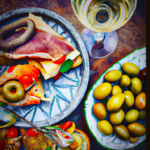videos for Foodies In this article, you will find some helpful tips on pairing food and wine for all you foodies out there. We will explore the basics of what makes a good pairing and how to enhance your dining experience. You will also discover some popular food and wine combinations to try, as well as some unexpected pairings that might surprise you. So, get ready to elevate your culinary adventures with these food and wine pairing tips!
Understanding Food and Wine Pairing
When it comes to enjoying a truly satisfying culinary experience, the importance of pairing the right food with the right wine cannot be overstated. The flavors and textures of the food can either complement or clash with the characteristics of the wine, making it essential to choose wisely. In this article, we will explore some valuable tips and guidelines to enhance your understanding of food and wine pairing.
Identifying complementary flavors
One of the fundamental aspects of food and wine pairing is identifying complementary flavors. The goal is to find wines that enhance the flavors of the dish, creating a harmonious balance on the palate. For example, a fruity and slightly sweet Riesling pairs beautifully with spicy Asian cuisine, as the wine’s sweetness helps to balance the heat of the dish. Similarly, a robust Cabernet Sauvignon goes hand in hand with a juicy steak, as the wine’s tannins cut through the richness of the meat, enhancing its flavor.
Balancing acidity and richness
Another key consideration in food and wine pairing is balancing acidity and richness. Acidic wines, such as Sauvignon Blanc or Champagne, can help cut through the richness of creamy dishes, providing a refreshing contrast. On the other hand, rich and buttery wines, like Chardonnay or Pinot Noir, complement dishes with heavy cream or butter-based sauces, creating a luxurious dining experience.
Considering texture and weight
Texture and weight also play an important role in food and wine pairing. Light-bodied wines, such as Pinot Grigio or Beaujolais, are well-suited for delicate dishes like seafood or salads. Their subtle flavors and lower alcohol content allow the food to take center stage. Conversely, full-bodied wines, like Bordeaux or Syrah, can handle heartier dishes like grilled meats or stews, as their complexity and intensity can match the robust flavors.
Matching Wine with Specific Foods
Now that we have explored the fundamental principles of food and wine pairing, let’s take a closer look at how to match wine with specific types of food.
Pairing wine with seafood
Seafood dishes can range from delicate and flaky to rich and buttery. For lighter seafood, such as oysters or grilled fish, a crisp and refreshing white wine like Sauvignon Blanc or Chablis is an excellent choice. These wines complement the delicate flavors of the seafood without overpowering them. For richer seafood, such as lobster or shrimp scampi, a buttery Chardonnay or a sparkling wine like Champagne can provide a perfect match, enhancing the richness of the dish.
Choosing the right wine for red meat
When it comes to pairing wine with red meat, bold flavors and tannins are crucial. A robust red wine, such as a Cabernet Sauvignon or a Syrah, can handle the intensity of red meat dishes like steak or lamb. The tannins in these wines help to cleanse the palate and enhance the flavors of the meat. For more tender cuts of red meat, like filet mignon or prime rib, a smoother and more elegant red wine, like a Merlot or a Pinot Noir, can be a wonderful choice.
Finding the perfect wine for cheeses
Cheese lovers rejoice! Pairing wine with cheese opens up a world of possibilities. The key is to find complementary flavors and textures. For soft and creamy cheeses like Brie or Camembert, a light and crisp white wine like Sauvignon Blanc or Chardonnay is an excellent match. For stronger and more pungent cheeses like blue cheese or Roquefort, a sweet dessert wine like Sauternes or Port can provide a beautiful balance. Hard cheeses like aged cheddar or Parmesan pair well with full-bodied red wines like Cabernet Sauvignon or Barolo.

Exploring Regional Pairings
Different cuisines and regions often have traditional food and wine pairings that have stood the test of time. Let’s take a closer look at some of these classic pairings.
Discovering classic French pairings
French cuisine is renowned for its elegance and complexity, and the wine pairings reflect this. One classic pairing is Coq au Vin, a rich and flavorful chicken dish cooked in red wine. This dish pairs beautifully with a red Burgundy or a Rhône Valley wine like Châteauneuf-du-Pape. Another timeless combination is steak frites, a simple yet delicious dish that goes hand in hand with a bold Bordeaux or a Côte du Rhône.
Exploring Italian wine and food combinations
Italian cuisine is a favorite among food enthusiasts, and the wine pairings are equally delightful. One classic pairing is pasta with red sauce, which pairs perfectly with a Sangiovese-based wine like Chianti or Brunello di Montalcino. Pizza, another Italian staple, can be paired with a medium-bodied red wine like Barbera or a sparkling Lambrusco. For richer dishes like Osso Buco or lasagna, a full-bodied wine like Barolo or Amarone can elevate the flavors.
Experimenting with fusion cuisine
Fusion cuisine combines elements from different culinary traditions, often resulting in vibrant and innovative flavors. This opens up exciting opportunities for food and wine pairings. For example, a spicy Thai curry can be paired with a semi-sweet Gewürztraminer or a sparkling Moscato. Korean barbecue, with its bold and smoky flavors, can be matched with a medium-bodied red wine like Malbec or a dry Riesling. The key is to find wines that can complement the unique flavors of fusion dishes while adding their own distinct character.
Understanding Wine Varieties
With countless wine varieties available, it can be overwhelming to navigate the world of wine. Let’s take a closer look at some popular wine varieties and their characteristics.
Exploring red wine varieties
Red wine lovers have a wide range of options to choose from. Cabernet Sauvignon is known for its bold flavors of blackcurrant and cedar, with firm tannins that provide structure. Merlot is often softer and more approachable, with flavors of black cherry and plum. Pinot Noir is known for its elegance and light to medium body, with delicate flavors of red berries and earthiness. Syrah is a full-bodied wine with dark fruit flavors and pepper notes.
Learning about white wine varieties
White wines offer a refreshing and diverse range of flavors. Chardonnay is a popular choice with its buttery texture and flavors of apple, pear, and vanilla. Sauvignon Blanc is known for its zesty and vibrant flavors of citrus, green apple, and grass. Riesling is a versatile white wine with a wide range of styles, from dry to sweet, and flavors of tropical fruit and floral notes. Pinot Grigio is light and crisp, with flavors of pear, lemon, and green apple.
Discovering unique wine varietals
In addition to the more well-known wine varieties, there are also unique and lesser-known varietals to explore. Grüner Veltliner is a white wine from Austria with flavors of white pepper, citrus, and green apple. Tempranillo is a red wine from Spain known for its bold flavors of cherry, vanilla, and tobacco. Chenin Blanc, originally from the Loire Valley in France, offers flavors of honey, apricot, and green apple. These unique varietals can add an exciting twist to your food and wine pairing adventures.

Pairing Wine with Different Cuisines
Food and wine pairing is not limited to traditional cuisines. Let’s explore how to pair wine with some popular global cuisines.
Pairing wine with Asian cuisine
Asian cuisine, with its wide range of flavors and spices, presents an interesting challenge for food and wine pairing. For sushi or sashimi, a dry and crisp white wine like Riesling or Sauvignon Blanc is a great choice. Spicy Asian dishes, such as Thai curry or Szechuan stir-fry, can be paired with off-dry white wines like Gewürztraminer or a fruity red wine like Beaujolais. The sweetness in the wine helps to balance the heat in the dish, creating a harmonious combination.
Choosing wine for spicy dishes
Spicy dishes from various cuisines, such as Indian or Mexican, require a thoughtful wine pairing to complement the heat. Off-dry white wines like Riesling or Chenin Blanc are excellent choices, as their slight sweetness counters the spiciness. Rosé wines, with their refreshing acidity and fruit flavors, can also pair well with spicy dishes. If you prefer red wine, opt for a fruity and low-tannin red wine like Gamay or Grenache.
Finding the right wine for Mediterranean fare
Mediterranean cuisine, known for its fresh ingredients and vibrant flavors, can be paired with a variety of wines. For light and refreshing dishes like Greek salad or grilled fish, a crisp white wine like Sauvignon Blanc or Vermentino is an excellent choice. For heartier dishes like lamb kebabs or roasted vegetables, a medium-bodied red wine like Sangiovese or Tempranillo can provide a wonderful balance. Rosé wines, with their versatility and ability to handle a range of flavors, are also a great choice for Mediterranean cuisine.
Mastering the Art of Wine Tasting
To truly appreciate and enjoy the nuances of wine, it is important to develop a wine tasting palate and understand the elements of wine. Let’s delve into the art of wine tasting.
Developing a wine tasting palate
Developing a wine tasting palate takes time and practice. Start by experiencing the visual aspects of wine, such as its color and clarity. Swirl the wine gently in the glass to release its aromas, then take a moment to inhale and identify the different scents. Next, take a small sip and let it linger on your palate, noting the flavors, acidity, tannins, and finish. With practice, you will become more adept at identifying and appreciating the intricate qualities of different wines.
Understanding the elements of wine
Wine is composed of various elements that contribute to its overall character. Acid plays a crucial role in balancing flavors, providing a crisp and refreshing sensation. Tannins, found primarily in red wines, create a drying and sometimes astringent sensation in the mouth. They can also help wines age and develop complexity. Sweetness is a perceptible amount of residual sugar in the wine, contributing to its overall flavor profile. Body refers to the weight and texture of the wine, ranging from light to full-bodied.
Learning the tasting process
The tasting process involves a series of steps to fully experience and evaluate a wine. Firstly, examine the appearance of the wine, noting its color and clarity. Then, assess the aromas by gently swirling the wine and inhaling deeply. Take note of any fruit, floral, or spice aromas, as well as any oak or earthy notes. Next, take a sip and let the wine coat your palate, paying attention to the flavors, acidity, tannins, and finish. Finally, make a judgment on the overall quality and enjoyability of the wine.

Tips for Buying and Storing Wine
Whether you are a seasoned wine enthusiast or a casual wine drinker, it is essential to know how to buy and store wine properly. Here are some valuable tips to consider.
Choosing the right wine for aging
Not all wines are meant for aging, and it’s important to choose the right wine if you are planning to cellar it. Generally, full-bodied red wines with high tannin and acidity, such as Cabernet Sauvignon or Bordeaux blends, are good candidates for aging. It is also important to consider the vintage, as some years produce wines that are more age-worthy than others. If you’re unsure, consult a trusted wine expert or do some research on the ideal aging potential of a specific wine.
Understanding wine storage conditions
Proper wine storage is crucial to maintaining the quality and integrity of the wine. Ideally, wine should be stored in a cool, dark, and humid environment to prevent premature aging or spoilage. The temperature should be consistent, ideally between 45°F and 65°F (7°C and 18°C), and the humidity between 50% and 80%. Wine should also be protected from vibration and strong odors, as they can negatively impact the wine’s aromas and flavors.
Finding good value wines
You don’t have to break the bank to enjoy a good bottle of wine. There are plenty of high-quality wines available at affordable prices. Look for lesser-known wine regions or varietals, as they often offer great value for money. Explore local wineries or attend wine tastings to discover hidden gems. Another tip is to seek out wines from recent vintages, as they tend to be more affordable compared to older, highly rated vintages. Don’t be afraid to experiment and try new things – you may be pleasantly surprised by what you find.
Pairing Wine with Desserts
No meal is complete without a satisfying dessert, and pairing the right wine can take the indulgence to another level. Let’s explore some tips for pairing wine with desserts.
Pairing wine with chocolate
Chocolate lovers rejoice! Pairing wine with chocolate can be a match made in heaven. For dark chocolate with higher cocoa content, a full-bodied red wine like Cabernet Sauvignon or Port is a natural choice. The rich tannins in these wines complement the bitterness of the chocolate, while their intense flavors don’t get overwhelmed. For milk or white chocolate desserts, a sweeter wine like a late-harvest Riesling or a sparkling Rosé can provide a delightful contrast, balancing the sweetness of the chocolate.
Choosing dessert wines for fruit-based treats
Fruit-based desserts, such as pies, tarts, or fruity sorbets, offer a different set of flavors and textures. Light and refreshing desserts, like a mixed berry sorbet, can be elegantly paired with a fruity and slightly sweet wine like a Moscato d’Asti or a Gewürztraminer. For richer and more decadent fruit desserts like apple pie or peach cobbler, a sweet and complex dessert wine like a late-harvest Gewürztraminer or a Sauternes can elevate the flavors, creating a luscious combination.
Exploring sweet wine options
Sweet wines are a perfect match for desserts that have a higher sugar content. They can provide a satisfying balance or a complementary sweetness. For example, a sweet dessert wine like a Muscat or a Tawny Port pairs beautifully with nut-based desserts like pecan pie or almond cake. A sweet Sherry wine like Pedro Ximénez is a heavenly match for rich and creamy desserts like crème brûlée or tiramisu. The key is to find a wine that can match the sweetness of the dessert while adding its own distinct flavors and complexity.

Exploring Wine and Cheese Pairings
Last but certainly not least, let’s explore the wonderful world of wine and cheese pairings. This classic combination has been enjoyed for centuries and offers endless opportunities for culinary pleasure.
Understanding the principles of cheese and wine pairing
When it comes to pairing wine and cheese, there are a few principles to keep in mind. It is important to find complementary flavors and textures. You can match similar flavors, such as a buttery Chardonnay with a creamy Brie, or contrast flavors, such as a sharp and salty blue cheese with a sweet dessert wine. It is also important to consider the intensity of the flavors, as a light and delicate cheese may be overwhelmed by a bold and robust wine. Experimentation is key, as different cheeses and wines can create unique and delightful combinations.
Matching wine with different cheese types
Different types of cheese require different wine pairings. For soft and creamy cheeses like Camembert or goat cheese, a crisp white wine like Sauvignon Blanc or Chardonnay can provide a refreshing balance. Hard cheeses like aged cheddar or Parmesan pair well with full-bodied and tannic red wines like Cabernet Sauvignon or Barolo. Blue cheeses, with their bold and pungent flavors, are perfectly complemented by sweet dessert wines like Sauternes or Port. The key is to find wines that can either enhance or balance the flavors of the cheese, creating a harmonious combination.
Experimenting with unique cheese and wine combinations
Don’t be afraid to think outside the box and experiment with unique cheese and wine combinations. There are countless variations and regional specialties to discover. For example, a smoky and spicy pepper jack cheese can be paired with a fruity and peppery Zinfandel. A tangy and creamy goat cheese can be complemented by a fresh and zesty Sauvignon Blanc. By exploring different flavor profiles and experimenting with new combinations, you can elevate your wine and cheese experience to new heights.
Conclusion
Food and wine pairing is a fascinating and enriching journey for any food lover. By understanding the principles of complementary flavors, balancing acidity and richness, and considering texture and weight, you can enhance your dining experience and truly appreciate the harmony between food and wine. Whether you are exploring regional pairings, understanding different wine varieties, or mastering the art of wine tasting, there is always something new and exciting to discover. With these tips and guidelines, you can confidently embark on your own food and wine pairing adventure, creating memorable moments of enjoyment and culinary delight. Cheers!




